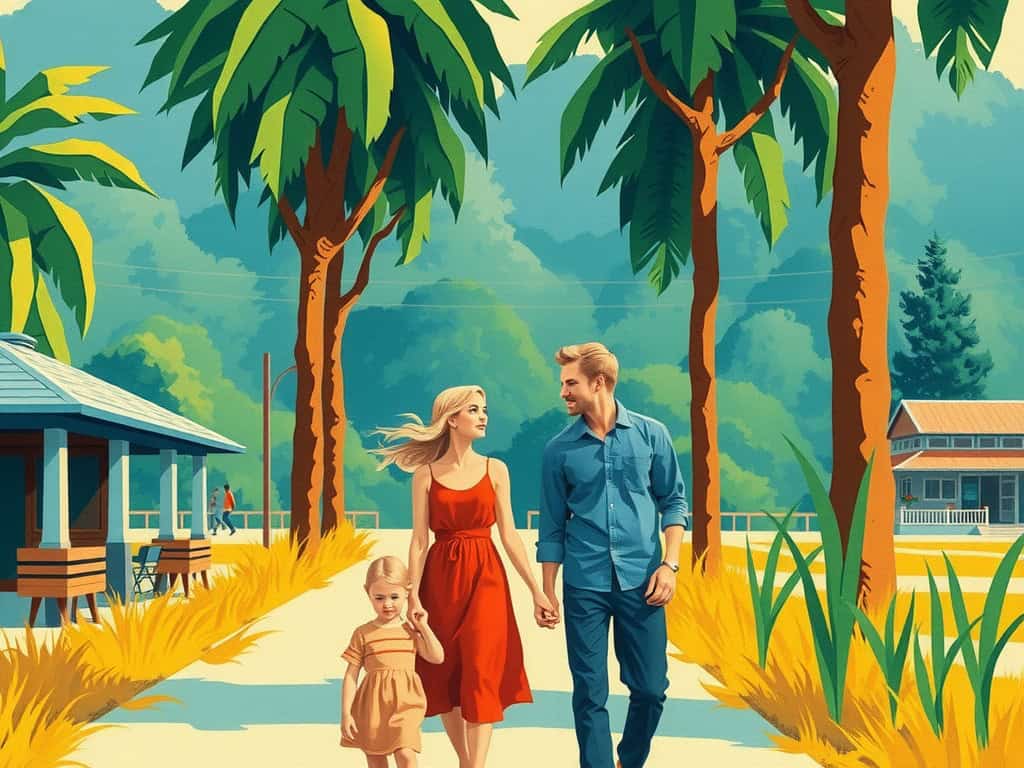Planning a move to Thailand? Come join us in Chiang Mai!
Chiang Mai is popular with expat families for good reason. The city offers a unique mix of Thai culture and international amenities, all wrapped up in a more relaxed package than you’ll find in Bangkok (and at a fraction of the cost).
Remote work families with the option to live wherever they like are especially gravitating to Chiang Mai as an established digital nomad hub.
Making the choice to live in Chiang Mai might be the easy part.
Narrowing down your choice of where to live in Chiang Mai can be a bit more challenging if you’re new to the city – which is why we’ve created this in-depth guide for expat families who plan to relocate.
Whether you prefer the buzz of city life, the comforts of suburban life, or rural idyll, we’ll help you find a neighborhood in Chiang Mai that feels just right.
Join us on a tour of Chiang Mai’s most family-friendly areas.
From the hip streets of Nimman to the spacious suburbs of Hang Dong, we’ll show you where the expat enclaves are and explain exactly what makes them popular and desirable places to live. Covering everything you need to know – from housing options, international schools, supermarkets, hospitals, and those all-important family amenities, get ready for a wealth of detail you won’t find anywhere else:
Urban Neighborhoods
Nimmanhaemin
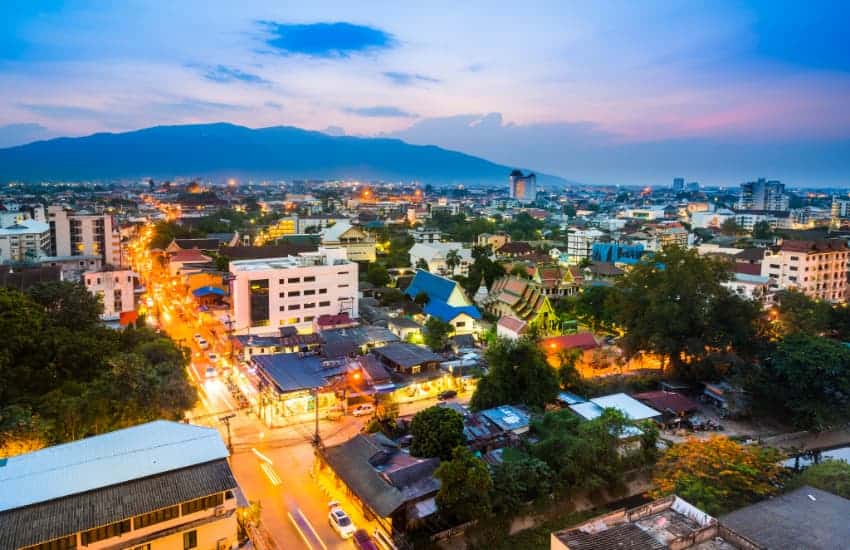
Urban Convenience with a Hip, Modern Vibe
Highlights:
- Hip, modern vibe with trendy cafes and co-working spaces
- Abundant Western-style amenities
- Modern condos and compact townhomes
Best for: Digital nomads, young professionals, and small families who prefer urban living
Transportation: Walkable, but motorbike recommended for easier navigation during rush hours
Cost of living: One of the most expensive areas, with modern condos priced between ฿15,000-30,000/month. High costs for food and daily necessities, driven by Western-style cafes, restaurants, and supermarkets like Rimping.
—
Nestled between the Old City’s western moat and the looming Doi Suthep mountain, Nimman (short for Nimmanhaemin Road) is Chiang Mai’s hipster heartland. It’s flanked by Huay Kaew Road to the north and Suthep Road to the south, with CMU’s sprawling campus and Doi Suthep just a stone’s throw away.
Once upon a time (read: a decade or two ago), Nimman was just another quiet ‘hood. Fast forward to today, and it’s the poster child for Chiang Mai’s rapid development. Digital nomads flock here like moths to a neon sign, drawn by the siren song of trendy cafes and co-working spaces. It’s the avocado toast of Chiang Mai neighborhoods – popular, a bit pricey, but oh-so-Instagram-worthy.
Nimman’s got energy to spare, especially along its main drag and cross-cut sois. It’s walker-friendly, but don’t expect a leisurely stroll during rush hour – the traffic can be as thick as the foam on your hipster latte. Green spaces? Not so much, unless you count the leafy CMU campus nearby. Housing here is all about location, location, location – think modern condos and compact townhomes. If you’re after a spacious garden, you might want to look elsewhere.
When it comes to expat-friendly amenities, Nimman’s got you covered. From artisanal coffee shops to swanky gyms, it’s like a little slice of the West dropped into northern Thailand. But don’t worry, you can still find some local flavor scattered around.
Expat-friendly Amenities in Nimman:
- International Schools: Northern International Montessori School, Singapore International School Chiangmai (SISB Chiangmai) nearby.
- Supermarkets: Rimping Supermarket Maya Lifestyle Branch, Tops Daily Suandok Park Chiang Mai nearby, Makro Food Service Sirimangkalajarn Branch.
- Hospitals & Clinics: Sriphat Medical Center and Maharaj Nakorn Chiang Mai Hospital nearby on Suthep Road, Chiang Mai Ram Hospital just beyond on the moat.
- Parks & Playgrounds: Huai Kaeo Arboretum, CMU campus, and Ang Kaew Reservoir nearby. Kaffekeen and Durianism Cafe for kid-friendly spaces.
Chang Klan
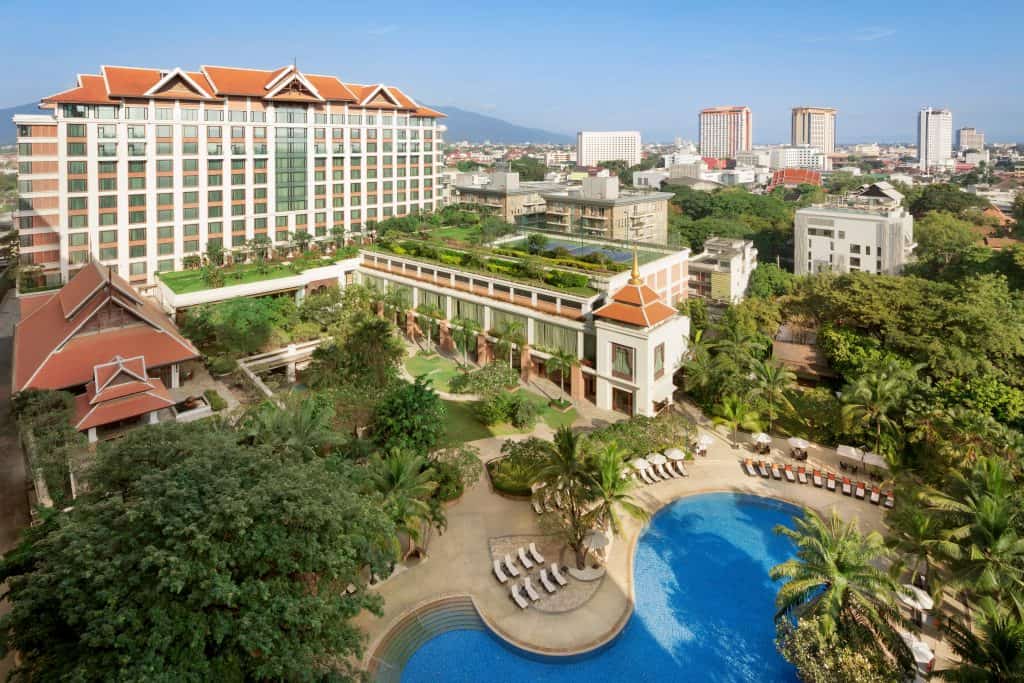
Central Location with a Slightly Upscale Feel
Highlights:
- Central location with an upscale feel
- Home to Night Bazaar and high-end hotels
- Mix of older Thai-style homes and new developments
Best for: Families seeking a central location with a mix of cultural influences
Transportation: Walkable in many areas, but car or motorbike useful for accessing other parts of the city
Cost of living: Housing costs are high at ฿15,000-30,000/month, with food and daily expenses slightly elevated due to Western supermarkets and restaurants in the area. It strikes a balance between Thai and Western options but tends towards the pricey end.
—
Situated just south of the Old City and bordering the Mae Ping River, Chang Klan offers a central location with a more upscale, yet local vibe. The area is home to the Night Bazaar and several high-end hotels, giving it a mix of touristy and local flavors. While Chang Klan itself doesn’t have a lot of green spaces, it’s close to the river, and some of the properties, especially condos and newer townhouses, cater to families seeking modern living with easy city access.
The housing market offers a mix of older Thai-style homes and new developments, but it can be hard to find large family homes with gardens. There’s a strong sense of community among expat families, thanks to proximity to several international schools and family-oriented amenities.
While Chang Khlan has fewer expat-specific offerings, it’s close to other well-equipped areas and offers some recreational spaces.
Expat-friendly Amenities in Chang Klan:
- International Schools: Chiang Mai International School in nearby Wat Ket.
- Supermarkets: The original Rimping Supermarket Nawarat Branch in nearby Wat Ket, Warorot Market further south along the river.
- Hospitals & Clinics: McCormick Hospital in nearby Wat Ket or Bangkok Hospital out on the Superhighway.
- Parks & Playgrounds: Charoen Prathet Public Park
Wat Ket Riverside
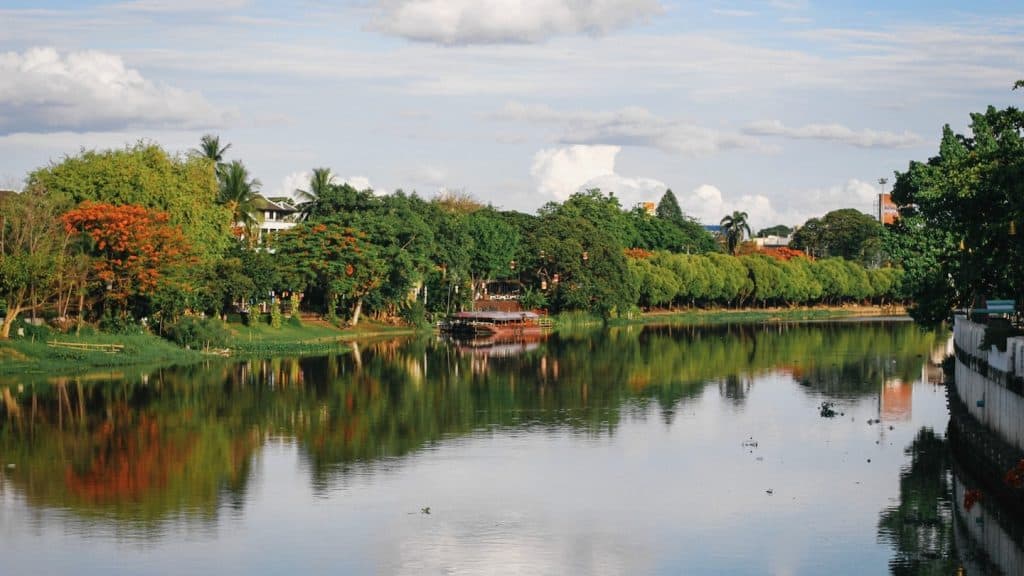
A Calm, Riverside Expat Haven
Highlights:
- Riverside location with a mix of old and new developments
- Long-standing expat area with Western amenities
- Close to city center and Superhighway
- International schools and high-end condos available
Best for: Expat families looking for a established community and riverside living
Transportation: Car or motorbike recommended, walkable along the riverside areas
Cost of living: Riverside condos and houses range from ฿15,000-35,000/month, with moderately high food and living costs due to its expat-friendly environment.
—
Wat Ket is where Chiang Mai’s expat story began, and it’s still writing new chapters today. Named after its central temple, this riverside neighborhood has been home to foreigners longer than anywhere else in the city.
For the OG digital nomads among us, Wat Ket holds a special place in Chiang Mai’s remote work history. Wawee Coffee by Narawat Bridge was one of the first popular spots to caffeinate and set up your laptop – long before “digital nomad” entered the lexicon.
Today, Wat Ket is a funky mix of old and new. Beautifully renovated historical homes sit alongside modern developments, creating a living timeline of Chiang Mai’s evolution. It’s not all smooth sailing though, there are real trafficky bits, and many areas are overrun with tourists.
But for many, the perks outweigh the challenges. Close access to both the city center and the Superhighway makes Wat Ket incredibly convenient. Charoen Muang Road takes you from Nawarat Bridge past McCormick Hospital, the train station and the old Arcade bus station all the way out to the superhighway and Central Festival.
If you’re after high-rise luxury living, the edge of Wat Ket, bleeding into Tha Sala, offers some of Chiang Mai’s swankiest condos.
Wat Ket has long catered to Western tastes, and it shows in the neighborhood’s amenities. From international schools to Western-style cafes and restaurants, you’ll find plenty of familiar comforts here. Expat-friendly Amenities in Wat Ket:
- International Schools: Chiang Mai International School, Windfield International School – Ecole Française Internationale.
- Supermarkets: Rimping Supermarket Nawarat Branch and Central Food Hall at Central Festival Shopping Mall nearby.
- Hospitals & Clinics: McCormick Hospital, Rajavej Chiang Mai Hospital and just neyond the Superhighway, Bangkok Hospital.
- Parks & Playgrounds: Charoen Prathet Public Park in nearby Chang Khlan.
Hai Ya
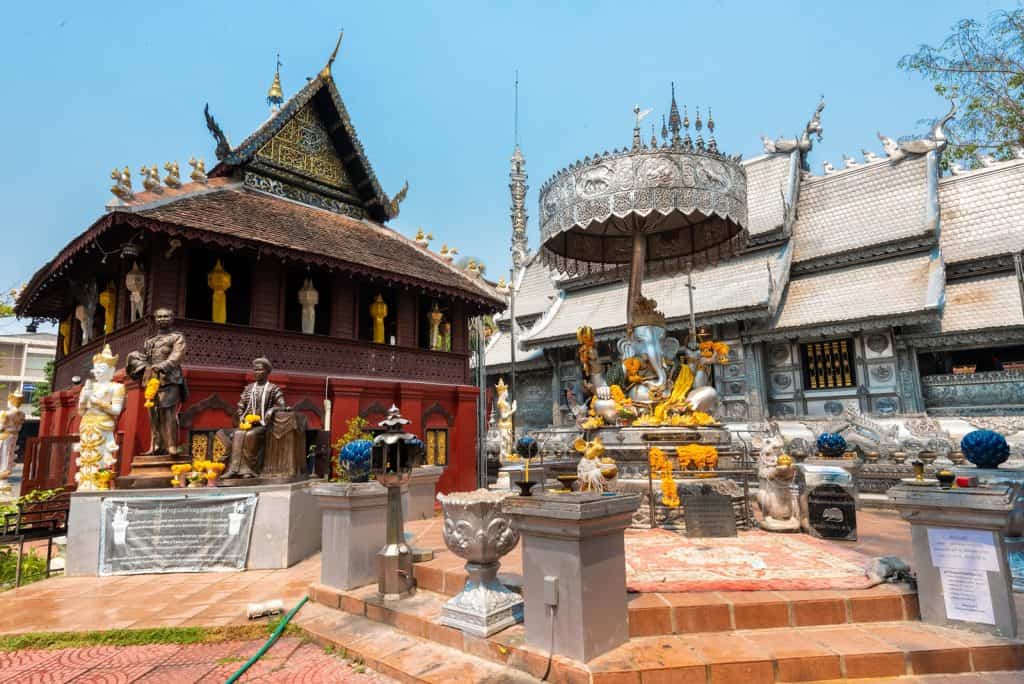
A Local Slice of City Life with with Hidden Family Gems
Highlights:
- Mix of local life and expat-friendly amenities
- Relaxed atmosphere with leisurely exploration opportunities
- Diverse housing options from nicely Thai home to modern apartments
Best for: Expats seeking a more authentic Thai living experience with some Western comforts
Transportation: Walkable for local exploration, motorbike recommended for broader access
Cost of living: More affordable housing options between ฿10,000-20,000/month, with lower food and living costs thanks to local markets. Western shopping is limited, keeping day-to-day expenses affordable overall.
—
South of the Old City lies Hai Ya, Chiang Mai’s unsung hero. Bookended by the Old City moat and the airport, this under-the-radar neighborhood offers a slice of local life with a side of expat-friendly amenities.
Hai Ya has long been a magnet for those in the know – a mix of Thai families and clued-in expats who appreciate its low-key charm. It’s where you might stumble upon a generations-old silversmith workshop next door to a trendy brunch spot – a living, breathing timeline of Chiang Mai’s evolution.
The atmosphere here is noticeably more relaxed than in the tourist-heavy areas. Traffic moves at a civilized pace, and the sois are quiet. Housing options cover all bases – from older Thai homes to modern apartments and new-build town homes. Some lucky folks even score a bit of garden space – a rare treat in the city.
While Hai Ya isn’t overflowing with Western amenities, that’s part of its charm. Local markets and long-standing Thai restaurants share space with an increasing number of international eateries and cafes.
Expat-friendly Amenities in Hai Ya:
- International Schools: Varee Chiangmai School in nearby Nong Hoi.
- Supermarkets: Tops Central Chiang Mai Airport, Rimping Supermarket Nim City Branch.
- Hospitals & Clinics: Chiang Mai Ram Hospital in nearby Suthep.
- Parks & Playgrounds: Hai Ya Garden, Nong Buak Hard Public Park and Kids Playground in nearby Old City.
Pong Noi
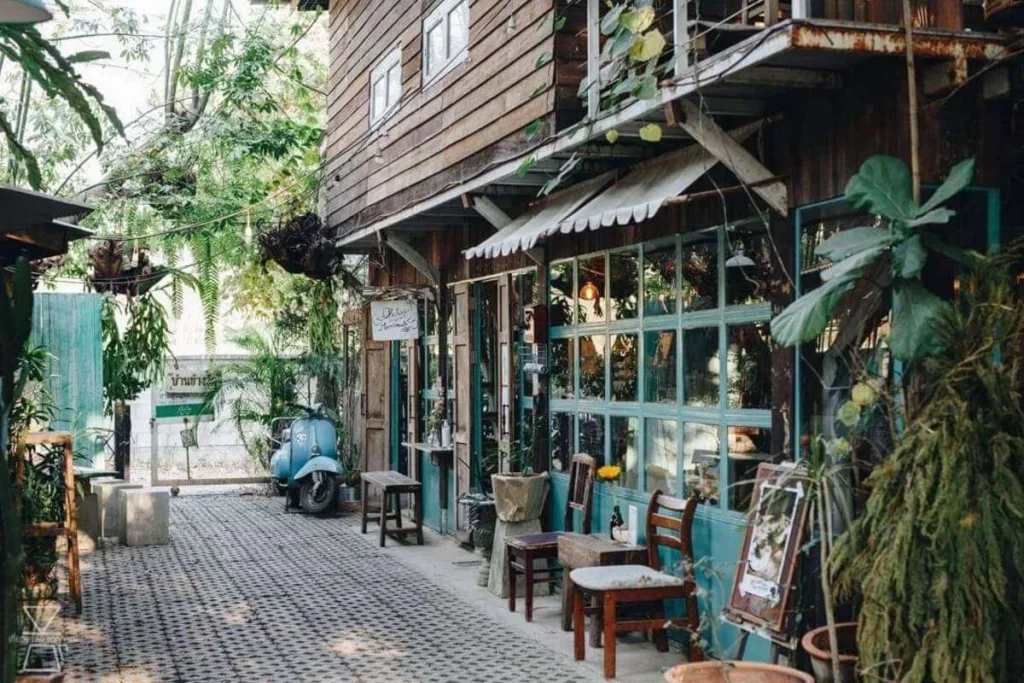
Green Residential Area Close to the City
Highlights:
- Green residential area close to the city
- Spiritual and creative hub with temples and artist villages
- Budget-friendly options near stylish cafes and market plazas
Best for: Artists, spiritual seekers, and families looking for a balance of nature and city access
Transportation: Motorbike is the preferred mode, some areas walkable but with tight spaces
Cost of living: Housing costs range from ฿12,000-25,000/month, offering a more affordable alternative to Nimman with access to both local markets and nearby Western conveniences. Daily living is moderately priced but higher if you frequent Western stores.
—
Nestled at the foot of Doi Suthep, Pong Noi is a beloved slice of Chiang Mai. Having called this neighborhood home ourselves, we can attest to its unique charm and hidden treasures.
Pong Noi is a spiritual and creative hub, dotted with temples like Wat Pong Noi, Wat Rampoeng, and Wat Umong along its back roads. The Baan Kang Wat artists village adds a hefty dose of creativity to the mix, making this area a haven for the artistically inclined.
While it’s budget-friendly thanks to its proximity to the university, Pong Noi doesn’t skimp on style. Pretty cafes and market plazas are sprinkled throughout, offering plenty of spots to while away an afternoon. The neighborhood hides some truly stunning houses, though yard space is at a premium. What it lacks in lawns, it makes up for in lush greenery.
You get to Pong Noi via the Canal Road, or by navigating the back soi that runs roughly parallel. Getting around can be a bit of an adventure – the narrow roads make motorbikes the transport of choice. It’s somewhat walkable, but be prepared for some tight squeezes.
When it comes to Western amenities, Pong Noi is more of a hidden gem than a one-stop-shop. You’ll find a sprinkling of expat-friendly cafes and restaurants, but for a full suite of Western conveniences, you might need to venture to nearby Nimman or Mae Hia. That said, its proximity to these areas means you’re never far from familiar comforts.
Expat-friendly Amenities in Pong Noi:
- International Schools: Northern International Montessori School near the airport, Ambassador Bilingual Academy, American Pacific International School Primary or Lanna International School in Mae Hia with more options further south in Hang Dong.
- Supermarkets: Shopping centers in Nimmanhaemin or Mae Hia are equally accessible.
- Hospitals & Clinics: Nearest options are Sriphat and Maharaj Hospitals on Suthep Road. Ram Hospital is a little further into the Old City and very popular with expats.
- Parks & Playgrounds: Nong Buak Hard Park is not far in the Old City, but the CMU Campus is nearby and the Ang Kaew Reservoir is a particularly nice parklike area open to the public.
Suburban Neighborhoods
Fa Ham
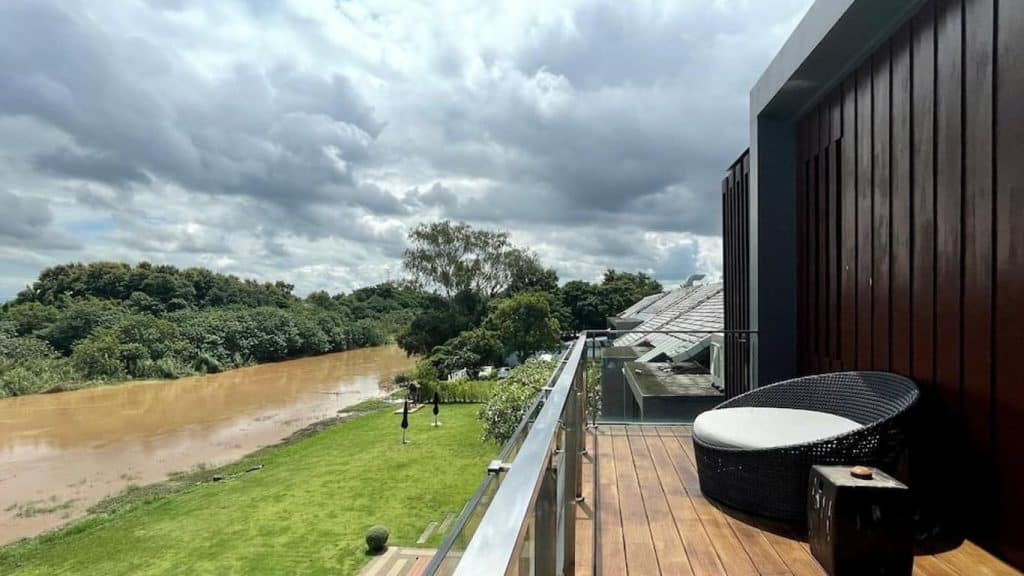
Suburban Comfort with a Familiar Western Feel
Highlights:
- Suburban comfort with familiar Western feel
- Known for Ruam Chok Mall and surrounding amenities
- Modern townhomes and mid-range gated communities
- Easy access to the city via Superhighway
Best for: Expat families seeking a balance of Thai and Western lifestyles in a suburban setting
Transportation: Car or motorbike recommended, some areas walkable
Cost of living: Mid-range housing from ฿10,000-20,000/month, with moderate living costs supported by both Thai markets and access to Western supermarkets at nearby Central Festival Mall. The area balances affordability and Western conveniences.
—
Fa Ham, often associated with the Ruam Chok area, is a popular suburban neighborhood just north of Chiang Mai’s Old City. It’s grown into an appealing option for expat families due to its balance between city convenience and a quieter suburban lifestyle. The area is well-known for Ruam Chok Mall and its surrounding complex, which offers Western-style supermarkets, coffee shops, and local eateries, which means you don’t have to trek all the way to the city center for familiar conveniences.
Housing in Fa Ham typically consists of modern townhomes and mid-range gated communities, offering more space compared to urban neighborhoods. Families appreciate the laid-back atmosphere, where daily life is a little slower, and the streets are less congested. Although Fa Ham is more developed than other nearby areas, it maintains a residential charm, and its proximity to the Superhighway makes commuting into the city easy.
Expat-friendly Amenities in Fa Ham:
- International Schools: Nakornpayap International School in San Phi Sua.
- Supermarkets: Rimping Ruam Chok, Tops Ruamchok Mall, and Lotus’s Ruamchok Chiang Mai.
- Hospitals & Clinics: Bangkok Hospital Chiang Mai is a jog away on the Superhighway
- Parks & Playgrounds: Chiang Mai Chaloem Phrakiat Park in nearby Chang Phueak.
Mae Hia
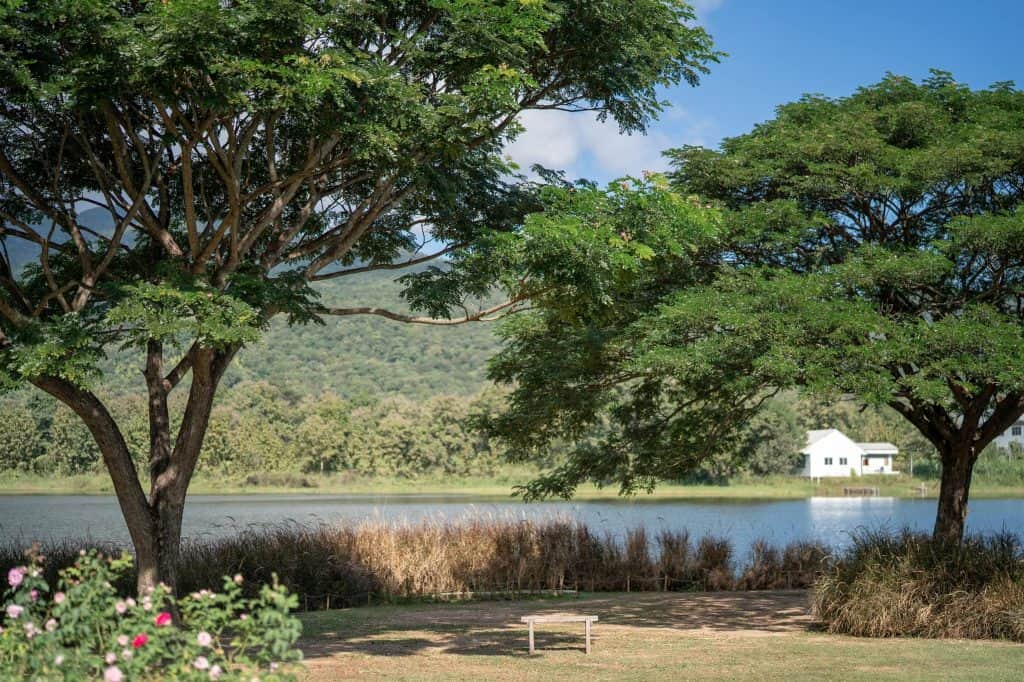
Edge of the City, Suburban Convenience
Highlights:
- Suburban area on the southwestern edge of the city
- Numerous gated communities with spacious homes and gardens
- Good balance of city access and quieter living
- Well-served with Western-style amenities
Best for: Expat families wanting suburban living with easy city access
Transportation: Car or motorbike necessary, not very walkable outside the gated communities
Cost of living: Housing ranges from ฿10,000-20,000/month, with moderate living costs due to a mix of local markets and some Western supermarkets nearby. A well-priced suburban option with access to both Thai and Western shopping.
—
Mae Hia sits on the southwestern edge of Muang Chiang Mai district, just south of the airport. It’s bordered by the Canal Road to the west and the Outer Ring Road to the south, providing easy access to both the city center and Hang Dong.
Once primarily agricultural land, Mae Hia has seen rapid development in recent years. It’s become a hotspot for expat families seeking a suburban lifestyle without straying too far from urban conveniences.
The vibe here strikes a balance between city and suburb. You’re close enough to zip into town for dinner, but far enough out to enjoy a quieter, more spacious living environment. Traffic is generally lighter than in the city center, though the main roads can get busy during rush hours.
Housing in Mae Hia is a big draw for many expats. You’ll find numerous moobans (gated communities) offering spacious homes with gardens. There’s also a mix of standalone houses and more modest Thai-style homes.
When it comes to expat-friendly amenities, Mae Hia is well-served. Its popularity with international families means you’ll find a good selection of Western-style supermarkets, restaurants, and services. You’re also just a short drive from the extensive offerings in Hang Dong.
Expat-friendly Amenities in Mae Hia:
- International Schools: Ambassador Bilingual Academy, American Pacific International School Primary (APISP). More schools further south in neighboring Hang Dong.
- Supermarkets: Rimping Supermarket Mae Hia, Makro Chiang Mai 2, Big C Supercenter Hangdong 1.
- Hospitals & Clinics: Dr Artima Medical Clinic.
- Parks & Playgrounds: Royal Park Rajapruek, Hannah • Hahn, Chamcha @ Doi Kham.
Pa Daet
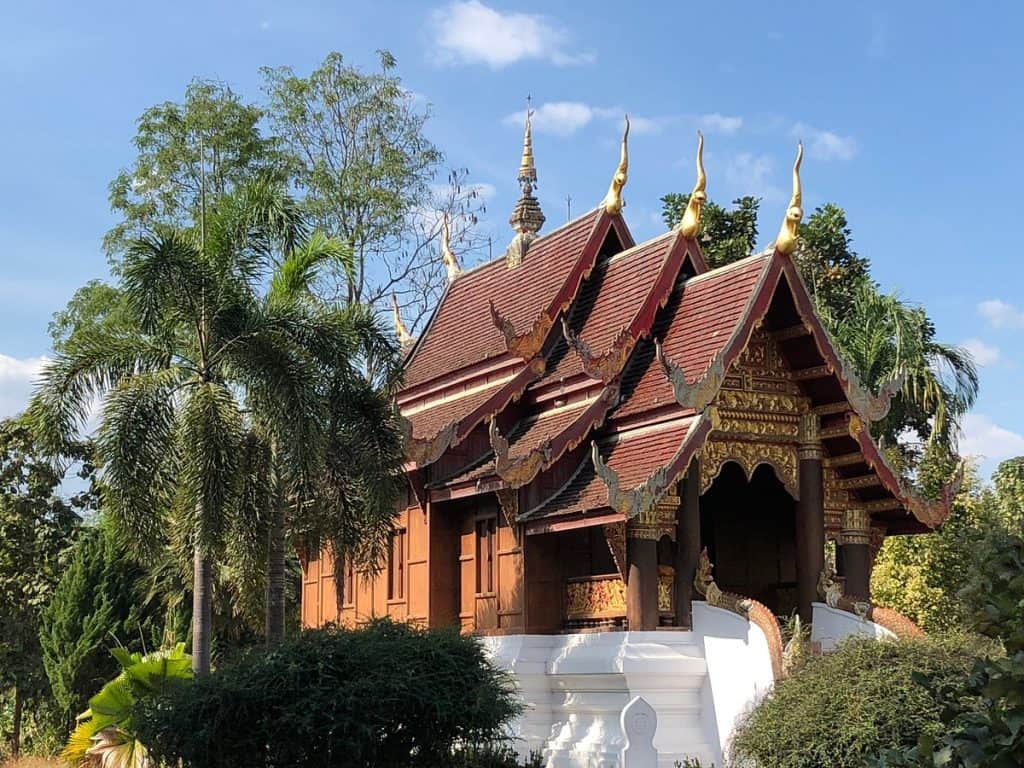
Broad Accessible Suburb with a Maze of Local Flavors
Highlights:
- Mix of Thai-style homes and new developments
- Authentic Thai life with growing Western conveniences
- Close to the airport and Hang Dong
Best for: Those seeking a more Thai experience but with some familiar comforts
Transportation: Car or motorbike necessary due to the area’s layout
Cost of living: Mid-range housing between ฿10,000-25,000/month, with affordable daily expenses mostly through local markets. Western goods are accessible but require travel, making the overall cost moderate.
—
Sandwiched between the meandering Ping River and the straight-shot Canal Road, Pa Daet is Chiang Mai’s southern suburb a hop, skip, and a jump from the airport. This neighborhood provides easy access to both the Old City’s charms and Hang Dong’s expat enclaves.
A particularly beautiful temple near the river gives this burb it’s name – a popular place for pilgrims to ask for boons of Buddha.
If you love well-organized, gridded street systems – stay far away from here! If there’s a sense or plan to Pa Daet’s sois, those are not discernable to the modern metropolitan. There are a lot of hidden gems to be found though, and the Goldilocks location – not too far, not too close to the city center – makes it well worth learning the local maze.
Pa Daet is a bit of a mixed bag, housing-wise. You’ll find traditional Thai homes rubbing shoulders with gated developments (Mooban Wang Tan is one of the most popular in Chiang Mai), some offering enviable views of the Ping River. It’s not exactly a walker’s paradise, but what it lacks in pedestrian-friendliness, it makes up for in variety. Traffic here is generally more manageable than in the city center, but rush hour can still pack a punch.
Amenity-wise, Pa Daet serves up a authentic slice of Thai life with a side of Western conveniences. You’ll find fresh markets (talad sot) and community markets (talad nat) alongside a sprinkling of Western-style supermarkets and eateries. It’s a balancing act – you can grab a croissant for breakfast, then haggle for mangoes at the local market for dessert.
Expat-friendly Amenities in Pa Daet:
- International Schools: Options available in nearby Mae Hia, about 10-15 minute drive.
- Supermarkets: Lotus’s Hangdong, Makro Hang Dong, Big C Hang Dong (the one with the Homepro).
- Hospitals & Clinics: Chiang Mai Klaimor Hospital.
- Parks & Playgrounds: After School, Let Grow, Chada Café and Restaurant.
Hang Dong
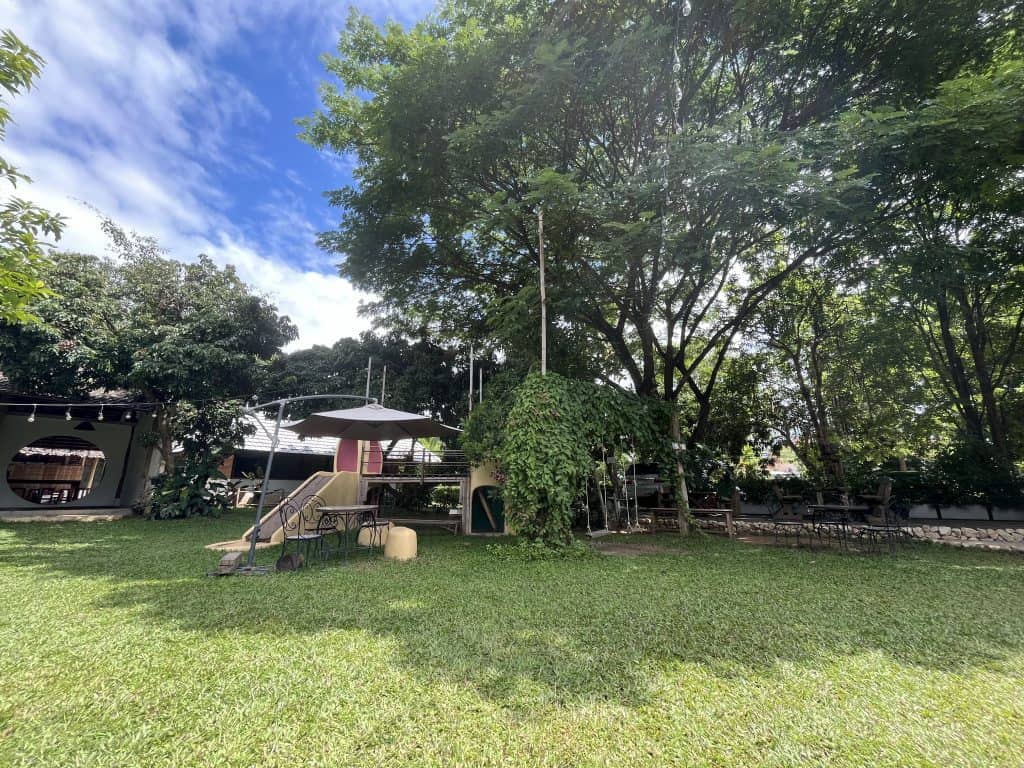
Chiang Mai’s Family-Friendly Hub
Highlights:
- Premier expat family hub south of the city
- Numerous gated communities and standalone homes
- Abundant international schools and Western amenities
Best for: Expat families seeking a spacious, suburban lifestyle with strong international community
Transportation: Car or motorbike necessary, not very walkable between different areas
Cost of living: Housing prices range from ฿12,000-30,000/month, with affordable daily living costs due to local markets. Living and eating Western-style will drive your costs up much higher though.
—
Hang Dong stretches south from the Outer Ring Road, with the Canal Road (kinda-sorta) forming its western boundary. It’s bisected by the Chiang Mai-Hot Road, which leads all the way down to Doi Inthanon National Park.
Once a sleepy rural district, Hang Dong has transformed into Chiang Mai’s premier expat family hub over the past couple of decades. It’s become the go-to area for those seeking a more spacious, suburban lifestyle without completely disconnecting from the city.
We might be biased (since we call Hang Dong home), but we have to say it’s THE best neighborhood in Chiang Mai for expat families. The vibe here is relaxed and family-friendly, with a strong sense of community among both expats and locals. You’ll find plenty of green spaces, including small farms and orchards interspersed among the housing developments.
Speaking of housing, Hang Dong is basically mooban-land. There’s plenty of standalone homes, but most expat families here opt for one of the many popular gated communities like Wang Tan, World Club Land or Sansaran.
When it comes to expat amenities, Hang Dong is hard to beat. Within a 5-10 minute drive, you’ll find just about everything an international family might need – from Western supermarkets and international schools to kid-friendly cafes and restaurants.
Expat-friendly Amenities in Hang Dong:
- International Schools: Lanna International School, Grace International School, SBS International School Chiangmai, The Nest International School, Meritton British International School, Chiang Mai Montessori International School, British Concordance International School, Panyaden International School, and American Pacific Internaitonal School.
- Supermarkets: Big C Supercenter Hangdong 2, Rimping Supermarket Kad Farang Branch. Mae Hia shopping centers are also just up the Canal Road.
- Hospitals & Clinics: Hang Dong Hospital and Klaimor Hospital up in nearby Pa Daet.
- Parks & Playgrounds: Nics Restaurant & Playground, YuuBaan Studio, Triplets Eat & Play, Bella Goose Cafe on the Pond.
San Sai
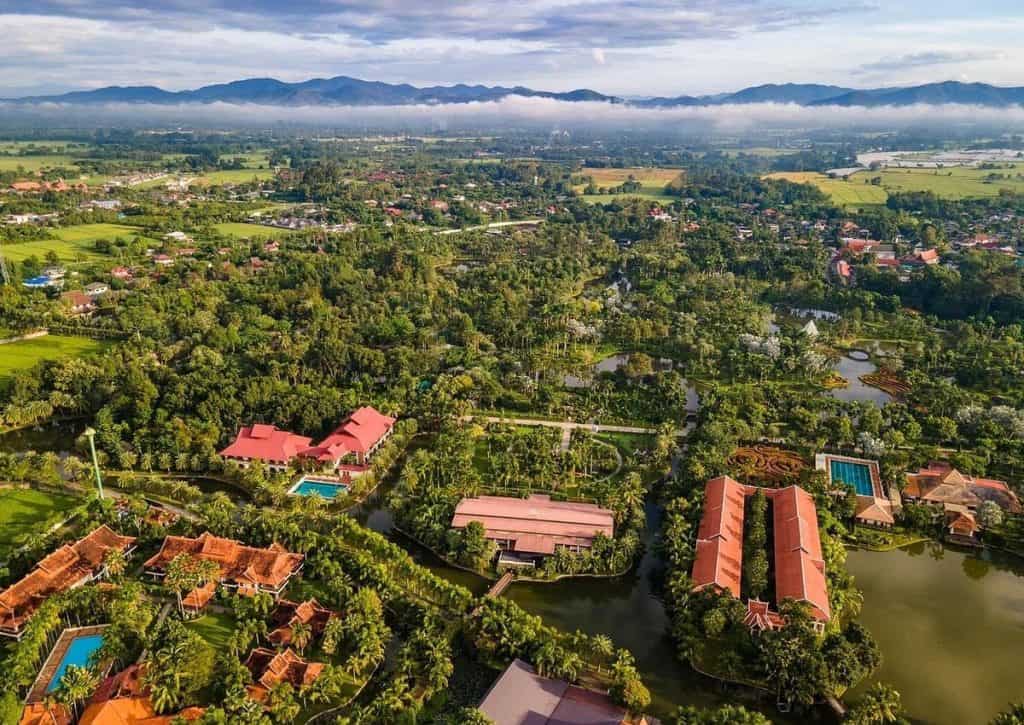
Affordable Suburban Hub Where Modern Meets Rural
Highlights:
- Sprawling suburban area north of the city
- Mix of modern developments and rural Thai life
- Spacious properties with gardens or small orchards
- Acessible Western amenities
Best for: Families looking for more space and a quieter lifestyle while still having city access
Transportation: Car or motorbike necessary due to the expansive area
Cost of living: Housing is very affordable at ฿8,000-15,000/month, and food and necessities are low cost if you rely on local markets. Traveling into town for Western amenities adds to your shopping as gas bills though.
—
Stretching north of Muang Chiang Mai, San Sai is like the city’s sprawling backyard. It’s bisected by the Chiang Mai-Phrao Road, with the 1001 highway skirting its eastern edge. This vast district runs from the edge of urban Chiang Mai all the way to the foothills of Doi Saket. Some would include Mae Jo within this district.
Once primarily agricultural land, San Sai has seen rapid development in recent years. It’s become a magnet for both Thai families seeking affordable housing and expats looking for a quieter, more spacious lifestyle.
The vibe here varies widely depending on where you land. Closer to the city, you’ll find modern housing developments and a growing number of amenities. Venture further out, and you’re in classic rural Thailand, complete with rice paddies and water buffalo. Traffic is generally lighter than in the city, but the main roads can get congested during rush hour.
Housing options in San Sai run the gamut from traditional Thai homes to modern gated communities. Many properties boast generous gardens or even small orchards – a rarity closer to the city center.
When it comes to Western amenities, San Sai is a work in progress. While you’ll find some international restaurants and stores, especially closer to the city, don’t expect the same concentration of expat-friendly options as in more central areas. That said, the trade-off is a more authentic Thai living experience, complete with vibrant local markets and a slower pace of life.
Expat-friendly Amenities in San Sai:
- International Schools: Lemur Lion Lamb Daycare, with more options in adjacent neighborhoods like Nakorn Payap International School.
- Supermarkets: Rimping Supermarket Meta Mall Branch and tons of supermarkets nearby in Ruam Chok.
- Hospitals & Clinics: Expat-friendly options available in about 20-30 minute drive.
- Parks & Playgrounds: San Sai Luang Municipality Public Park, LOL Kids Castle, Lenmaii Playground & Cafe.
Saraphi
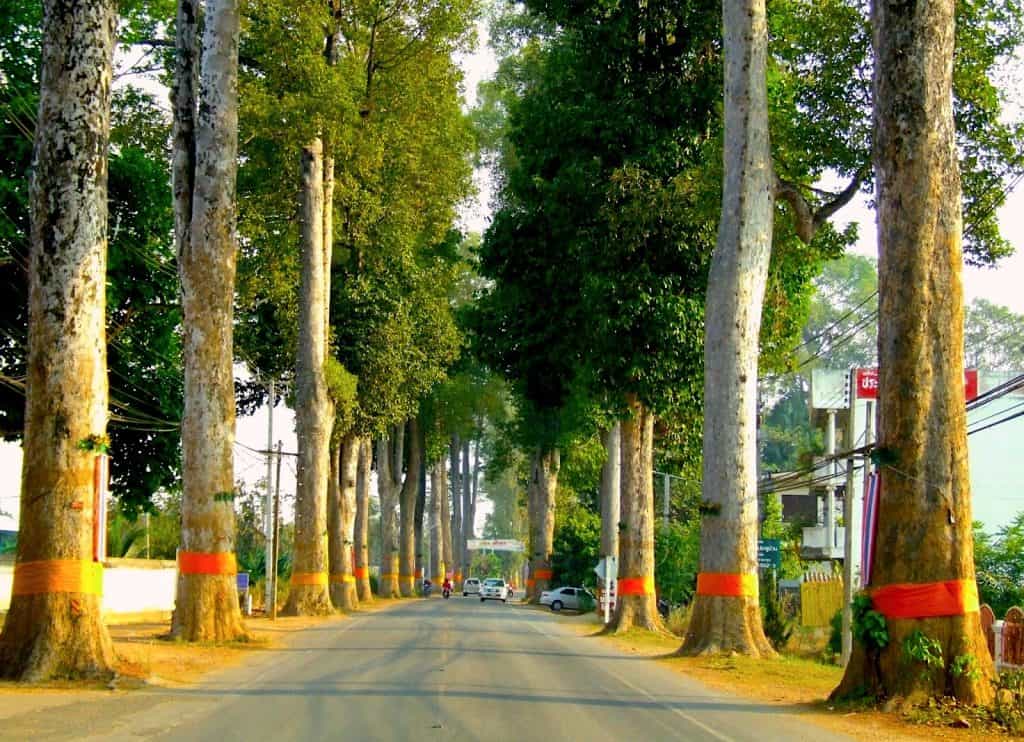
Charming Riverside Living to the South
Highlights:
- Charming riverside area south of Chiang Mai
- Mix of rural charm and suburban convenience
- Known for longan orchards and quieter pace of life
- Established expat population, especially in Nong Phueng sub-district
Best for: Those seeking a balance between rural Thai living and city access
Transportation: Car or motorbike necessary, especially for commuting to the city
Cost of living: Generally lower than city center, but varies by specific location. Housing is mid-range at ฿10,000-20,000/month, with affordable daily living costs.
—
Stretching south from Chiang Mai city, Saraphi district offers a picturesque blend of rural charm and suburban convenience. The area is bisected by the Chiang Mai-Lamphun Super Highway, with the older Chiang Mai-Lamphun Road providing a more scenic route along the Ping River. Nong Phueng, a sub-district of Saraphi, sits in the northern part of the district, closest to Chiang Mai city.
Once overlooked by expats in favor of areas to the east and west, Saraphi has been gaining attention for its charming riverside communities, longan orchards, and quieter pace of life. It’s become particularly popular with those seeking a balance between rural Thai living and easy city access.
Life here moves at a gentler pace than in Chiang Mai proper. The landscape is a patchwork of orchards, rice fields, and small villages, interspersed with newer housing developments. Traffic is generally light off the main roads, though the superhighway can get busy during commute times.
Housing options in Saraphi range from traditional Thai homes to modern developments, often offering more space than you’d find closer to the city. Riverside properties are particularly sought after, while Nong Phueng sees a mix of village homes and newer, more Western-style houses in small developments.
While not as saturated with Western amenities as areas closer to the city center, Saraphi’s proximity to Chiang Mai means you’re never too far from familiar comforts. The growing expat population, particularly in Nong Phueng, has led to an increase in international options.
Expat-friendly Amenities in Saraphi:
- Hospitals & Clinics: Saraphi Hospital (public)
- Parks & Playgrounds: Nong Phueng Municipal Park
Further Afield
Nam Phrae
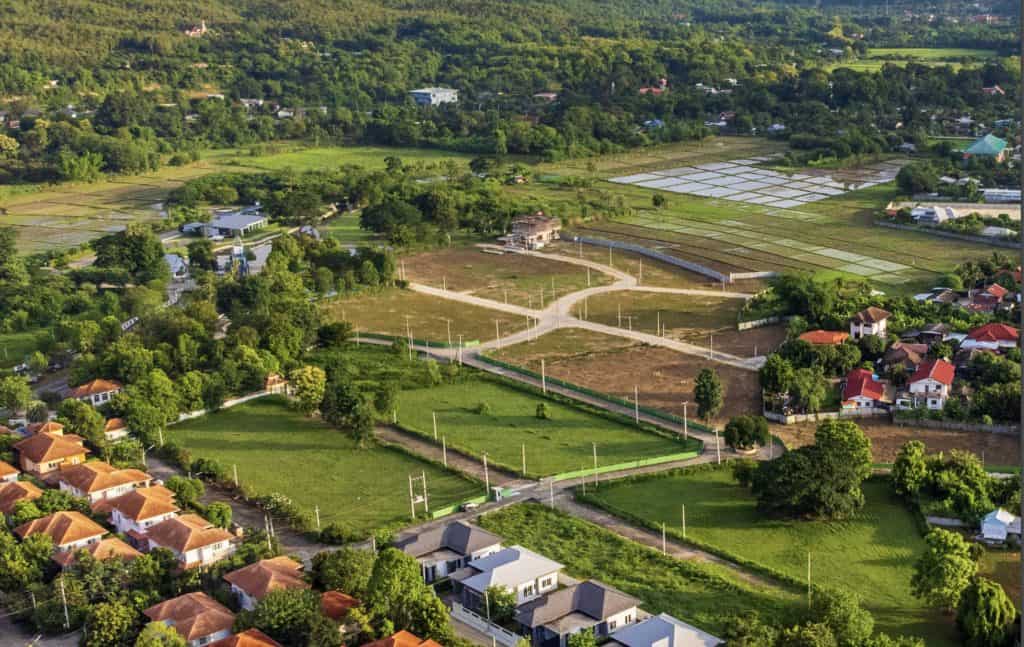
Up-and-Coming Area with Spacious Homes
Up-and-Coming Area with Spacious Homes
Highlights:
- Rural area further south with spacious, often luxurious homes
- Beautiful countryside and mountain views
- Growing number of upscale amenities and farm cafes
Best for: Wealthy expats or retirees seeking a quiet, high-end rural lifestyle
Transportation: Car necessary due to distance from the city and rural setting
Cost of living: Spacious homes range from ฿10,000-20,000/month, with low overall living costs if relying on local markets.
—
Nam Phrae lies further south of Hang Dong, about 30 minutes from the city center. It’s accessed via the Chiang Mai-Hot Road, which continues south towards Doi Inthanon.
This area has long been known for its beautiful countryside and spacious properties. In recent years, it’s started to attract more attention from expats and wealthy Thais looking for a quieter, more rural lifestyle.
Nam Phrae still feels quite far out of town, maintaining a distinctly rural vibe. It’s peaceful and green, with a landscape dotted with small farms, orchards, and the occasional luxury villa. Traffic is minimal here, replaced by the sounds of nature.
Housing in Nam Phrae tends towards the high end. You’ll find large, often luxurious homes set on expansive plots of land. Many properties boast stunning mountain views and resort-like amenities.
As for Western conveniences, Nam Phrae is still catching up. While there’s a growing number of expat-oriented cafes and restaurants, you’ll likely need to head into Hang Dong or the city for major shopping. However, we have a feeling it’s going to get more boujie – there will likely be more development of amenities to serve all these fancy homes in the next few years. Or you know, maybe not. Maybe it will maintain this vaguely genteel farm feel for years to come.
Expat-friendly Amenities in Nam Phrae:
- International Schools: Panyaden International School, with more options in nearby Hang Dong.
- Supermarkets: Options available in Hang Dong, about 15-20 minute drive.
- Hospitals & Clinics: Hang Dong Hospital, about 15-20 minute drive.
- Parks & Playgrounds: Options available in Hang Dong, about 15-20 minute drive.
San Kamphaeng
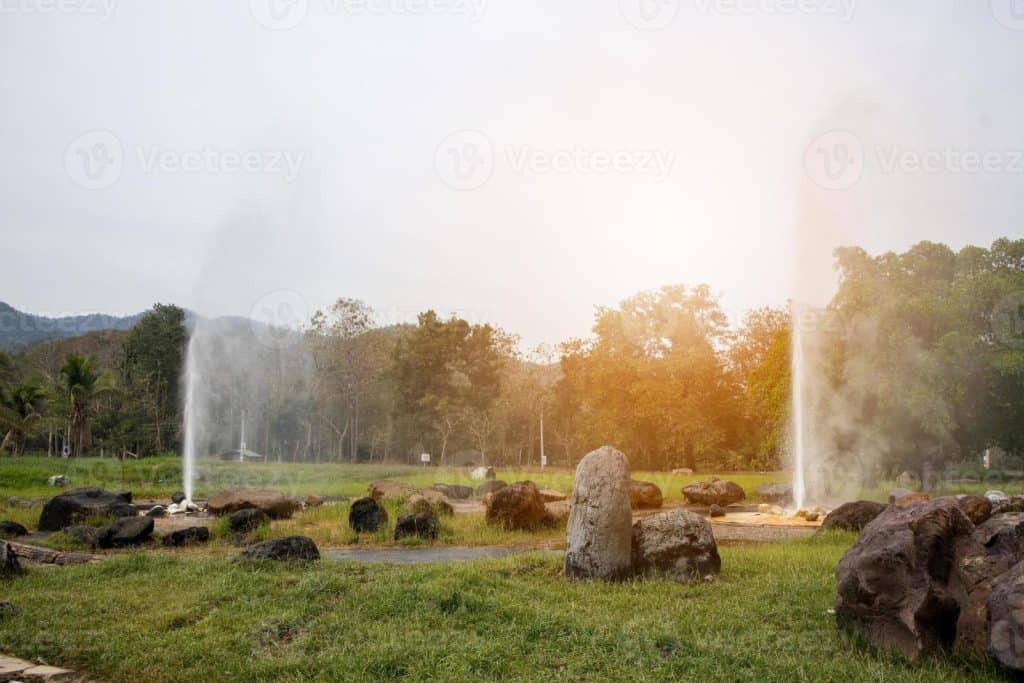
Hot Springs and Handicrafts in a Thai Time Capsule
Hot Springs and Handicrafts in a Thai Time Capsule
Highlights:
- Known for hot springs and traditional handicrafts
- Authentic Thai living experience
- Slower pace of life with small villages and craft workshops
- Growing expat presence but still very Thai
Best for: Those seeking an immersive Thai cultural experience away from the city
Transportation: Car or motorbike necessary, especially for trips to the city
Cost of living: Housing starts at ฿8,000-15,000/month, with low daily living costs thanks to an emphasis on Thai markets. Western products are scarce, keeping overall costs low and affordable.
—
Located about 30 minutes east of Chiang Mai city, San Kamphaeng is best known for its natural hot springs and traditional handicrafts. The San Kamphaeng Road (Route 1006) serves as the main artery, connecting the area to the city.
While it hasn’t seen the same influx of expats as some other areas, San Kamphaeng has been quietly attracting those looking for a more authentic Thai living experience – the longtimers will tell you this is where you go if you want to experience Chiang Mai much like it was decades ago. Its mix of natural beauty, traditional crafts, and laid-back lifestyle that offers unique appeal.
Life here moves at a distinctly slower pace than in the city. The area is dotted with small villages, craft workshops, and farming communities. Traffic is generally light, though the main road can get busy on weekends with day-trippers from the city.
Housing options in San Kamphaeng tend towards the traditional, with a mix of Thai-style homes and small housing developments. You’ll find more space here than in the city, often with room for a garden.
While Western amenities are less abundant here, the area’s growing popularity means you’ll find some expat-oriented businesses, particularly closer to the city.
Expat-friendly Amenities in Sam Kamphaeng:
- International Schools: Chiangmai Cedar International School
- Hospitals & Clinics: San Kamphaeng Hospital (public)
- Parks & Playgrounds: San Kamphaeng Hot Springs, Muang On Cave
Mae Rim
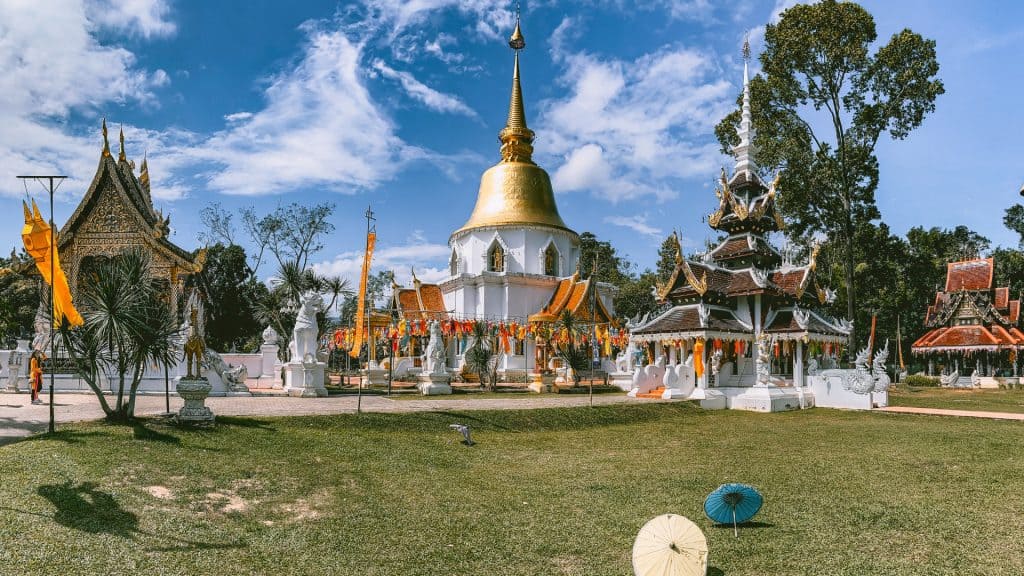
A Green Haven for Nature Lovers
Highlights:
- Green haven for nature lovers, 30 minutes north of the city
- Cooler climate and abundant outdoor attractions
- Housing options from Thai-style homes to luxury villas
- Surprising array of international amenities
Best for: Nature enthusiasts and families seeking a more rural lifestyle with some Western comforts
Transportation: Car or motorbike necessary due to distance from the city
Cost of living: Can vary widely depending on housing choice, generally lower than city center. Housing is affordable, ranging from ฿10,000-25,000/month. Western shopping options are limited, keeping costs down but requiring travel for certain goods.
—
Nestled about 30 minutes north of Chiang Mai city, Mae Rim is a verdant paradise stretching from the foothills of Doi Suthep-Pui National Park to the banks of the Ping River. The Chiang Mai-Fang Highway cuts through its heart, providing easy access to both the city and the mountainous north.
Long popular with nature-loving expats, Mae Rim has been attracting families for years. Its cooler climate, abundant greenery, and proximity to outdoor attractions make it a hit with those seeking a more laid-back, nature-oriented lifestyle.
The vibe here is worlds apart from city living. Think lush landscapes, winding country roads, and the occasional elephant sighting (for real!). Traffic is minimal, save for the main highway during rush hours. Instead of urban noise, you’re more likely to hear birdsong and the rustling of leaves.
Housing in Mae Rim runs the gamut from modest Thai-style homes to luxury villas. Many properties boast generous land, perfect for those green-thumbed expats looking to try their hand at tropical gardening.
While Mae Rim keeps it real with plenty of local markets and authentic Thai eateries, it’s not without its Western comforts. You’ll find a surprising array of international amenities, catering to the area’s sizeable expat population.
Expat-friendly Amenities in Mae Rim:
- International Schools: Prem Tinsulanonda International School
- Supermarkets: Makro Mae Rim, Rimping Supermarket at the new Kad Farang Mae Rim.
- Hospitals & Clinics: Nakornping Hospital
- Parks & Playgrounds: Huay Tung Tao Lake, Queen Sirikit Botanic Garden
How to Find the Perfect Neighborhood in Chiang Mai for Your Family
Chiang Mai is a cozily small city. One of the reasons we love living here is because it’s easy to get around and explore. That said you’re likely to stick to your local neighborhood most of the time, especially when you’ve got kids in tow, so where you choose to live will really define your experience in the city.
You’ll want to think long and hard on this important decision. Our tips for thinking it through:
- Consider Your Commute: If you have a job with a physical location, start your search by looking at neighborhoods within a comfortable commute distance. This will be your primary factor in narrowing down options.
- School Locations: For families with school-age children, the location of your chosen school(s) will likely define your search radius. International schools are scattered throughout Chiang Mai, so this can significantly influence your decision.
- Prioritize Your Lifestyle Needs: Consider what amenities are most important to your family’s quality of life. This could include:
- Housing size and style (apartments, houses, gated communities)
- Walkability of the area vs needing a car
- Proximity to restaurants and takeout options
- Access to green spaces and outdoor activities
- Nearness to community hubs like churches
- Explore in Person: Before committing to a lease, we strongly recommend spending time in your potential neighborhood. Chiang Mai has funny microclimates, it will rain in one part and not three streets over. The same goes for local vibes which can change dramatically from one street to the next.
- Consider the Season: If possible, visit during different times of the year. Some neighborhoods can be significantly affected by seasonal changes, such as increased traffic during tourist high seasons or air quality issues during burning season.
- Budget Realistically: Remember that while housing costs might be lower than in your home country, other expenses like international school fees can be significant. Factor in all costs when choosing your location.
- Think Long-Term: Consider your future needs. If you’re planning to expand your family or potentially work from home, ensure your chosen neighborhood can accommodate these changes.
- Connect with the Community: Reach out to expat groups or online forums specific to your chosen neighborhoods. First-hand experiences from other families can provide invaluable insights.
Navigating all these factors can be overwhelming, especially if you’re planning your move from abroad. That’s where our personalized relocation consultation service comes in handy. We’ll hit the pavement on your behalf, considering your family’s unique requirements and preferences.
Our local expertise allows us to:
- Provide in-depth insights into neighborhoods that match your criteria
- Offer virtual tours and real-time updates on potential homes
- Connect you with reputable and trustworthy real estate agents
- Share insider knowledge on upcoming developments or changes in different areas
- Help you navigate any cultural considerations or local regulations
By leveraging our service, you can save time, avoid common pitfalls, and ensure you’re making the most informed decision for your family’s new life in Chiang Mai.
Get more info and book a call here.
Remember, finding the right neighborhood is about balancing practicality with the lifestyle you envision for your family. Whether you’re drawn to the bustling energy of Nimman, the family-friendly suburbs of Hang Dong, or the natural beauty of Mae Rim, Chiang Mai has a perfect spot for you. With careful consideration and perhaps a little expert help, you’ll find a neighborhood that not only meets your needs but exceeds your expectations for your Thai adventure.
Ready to start your neighborhood hunt? Contact us for a personalized relocation consultation and take the first step towards finding your ideal Chiang Mai home!
What is Chiang Mai Like for Expat Families?
Chiang Mai is where remote working families come to tune out the ping of constant Slack notifications and tune in to the sound of temple chimes.
If you want big energy and a fast-paced environment… Erm, go elsewhere for hustle culture.
Chiang Mai will beat that tendency out of you – it did for this recovering workaholic!
Life here is sabai sabai and all about working to live, not living to work.
Add to that an open, smiling, and accepting culture that cherishes children, and you’ve got a foundation for a pretty wholesome family life.
Come here to design your ideal family lifestyle, whether that means embracing the digital nomad ethos or learning to do things the Thai way.
What truly sets Chiang Mai apart is the freedom it offers. Freedom to choose a lifestyle that aligns with your family’s values.
Want to homeschool your kids while running an online business? Go for it. Prefer to enroll them in an international school while you teach English part-time? That’s an option too. Dreaming of opening that café you’ve always talked about? Chiang Mai’s entrepreneurial spirit has got your back.
In Chiang Mai, family life isn’t about ticking boxes or keeping up with the Joneses. It’s about creating a lifestyle that brings out the best in each of you. It’s about slowing down, tuning in, and rediscovering what really matters.
Ready to turn those daydreams into reality? Let’s dive deeper into why expat families love Chiang Mai so much.
Cost of Living: Options for Every Budget
First up, let’s address the elephant in the room (and no, I’m not talking about the ones at the sanctuaries). We’re talking about how affordable life in Chiang Mai is, for real.
Chiang Mai isn’t simply “cheap” – it offers excellent options at every price point. A Thai family here can enjoy a good quality of life on a monthly salary of ฿45,000, while some millionaire expats splurge that same amount on a glamping weekend for the fam.
Most of us fall somewhere in the middle. As a family primarily living on my husband’s income as a freelance software developer, we live well here!
While definitely more affordable than Bangkok or Phuket, and significantly cheaper than Singapore or Hong Kong, Chiang Mai also offers better value on things that count like clean food, quality healthcare, and enriching experiences. The key is: you can find your sweet spot, whatever your budget.
Education: A World of Choices
The education landscape in Chiang Mai has exploded in recent years. When I was growing up, there were only three schools for the farang kids. Now, there are nearly 30 international schools and bilingual programs! You can choose from IB curriculum at Prem, British system at Lanna, Christian education at Grace, or embrace Buddhist philosophies at Panyaden. There’s even a French school and a German school.
However, it’s worth noting that these international programs can be quite expensive – often the single greatest expense for expat families here. For more budget-friendly options, Thai schools are much cheaper as several have English programs. There’s also a growing community for those who prefer homeschooling or worldschooling, which is the route we’re planning to take with our kids.
Safety and Healthcare: Peace of Mind Included
Chiang Mai is widely regarded as one of Thailand’s safest cities, making it an appealing choice for families. The low crime rates and welcoming community foster an environment where people feel at ease. Neighborhoods are generally safe, with a friendly atmosphere that encourages outdoor activities and family engagement.
In terms of healthcare, Chiang Mai offers a range of international-standard facilities, such as Bangkok Hospital Chiang Mai and Ram Hospital, which provide high-quality care with English-speaking staff. Numerous clinics and pharmacies throughout the city offer accessible options for minor ailments and preventative care. Many expats appreciate the affordability of medical services here compared to Western countries. This combination of safety and accessible healthcare really lends peace of mind.
Housing: Modern Comfort in Thai Style
Chiang Mai offers a range of housing options, with many affordable homes renovated to international standards. If you’re looking to indulge your sense of romance, you can rent a wooden stilt house, traditional of northern Thailand, but most homes on the market are comfortably modern.
From air conditioning to Western-style kitchens, you can easily find the amenities you’d expect “back home.” Gated communities are popular amongst expat families and offer suburban-style homes with access to community swimming pools, playgrounds, and green spaces.
One thing to keep in mind, however, is that Thailand’s housing market is protected for locals. Foreigners living in Thailand may purchase condos, but not land and houses, so that means most expat families rent.
Family-Friendly Amenities: It’s a Kid’s (and Parent’s) Paradise
Chiang Mai is well-equipped with family-friendly amenities, blending urban conveniences with easy access to nature. While the city may not have many sprawling parks, it makes up for it with proximity to outdoor attractions like Doi Suthep National Park, Huay Tung Tao Lake, and Bua Tong Waterfalls. Within the city, Nong Buak Haad Public Park in the Old City is popular for family picnics and casual play.
For day-to-day needs, international grocery stores like Rimping and Tops stock familiar Western products. Large shopping centers such as Central Festival and Maya Mall offer retail, dining, and entertainment options, including movie theaters and indoor play zones for kids. The city’s thriving café culture caters to families with child-friendly menus and play areas. Weekend markets, art workshops, and farm visits add fun and edutainment for all ages.
For an extensive list of family-friendly spots, check out our article on 60+ Kid-Friendly Places in Chiang Mai.
Getting Around and Road Safety: The Realities of Chiang Mai
As a small, spread-out city, Chiang Mai is super easy to get around. You’ll have to do that of your own accord though.
Public transport is limited to red songthaews (shared trucks) and a few buses, so most expats rely on private vehicles—motorbikes or cars—for daily travel. Walking isn’t very practical in many areas due to poor sidewalks, chaotic traffic, and the sprawling nature of the city.
Riding motorbikes is the norm for Thai families, but it’s not without risk, as road safety in Thailand can be unpredictable, with frequent accidents and minimal enforcement of traffic laws. If you’re planning to live here with kids, investing in a car is the safest and most convenient option.
Chiang Mai’s traffic isn’t near as overwhelming as in Bangkok, but it definitely exists. Congestion during rush hours—especially around schools—can be significant. Areas like Nimman, Old City, Chang Klan, and Hang Dong Road see heavy traffic, particularly in the mornings (7:30-9:00 AM) and afternoons (4:30-6:30 PM).
In general though, it’s easy and safe to get around.
Visa Options for Families: Great News for Remote Workers
Thailand offers several visa options for families looking to stay long-term in Chiang Mai. The new Destination Thailand Visa (DTV) is particularly exciting for remote work families, as it includes options for dependents. You can explore our comprehensive guide to the DTV here and see tips for applying with family.
For those over 50, there’s the retirement visa, while families with school-age children often opt for education visas. Expats with work permits can apply for dependent visas for their spouse and children.
Final Thoughts: You’re Not Just Moving – You’re Choosing a Way of Life
Choosing a neighborhood in Chiang Mai isn’t just about real estate. It’s about how you want your family to live, connect, move, eat, grow, and breathe.
Whether you crave the buzz of city living, the space of the suburbs, or the slower rhythm of the countryside, Chiang Mai offers a pocket of paradise to match. Some families prioritize walkability and proximity to brunch. Others want mango trees, mooban playgrounds, or mountain views. All of that exists here. You just need to know where to look.
This guide was built to save you the hours (and headaches) of trying to piece it all together alone. We live here, we raise our kids here, and we’ve helped dozens of families find their footing in Chiang Mai.
Still unsure where to begin? We offer 1-on-1 relocation consultations to help you navigate housing, schools, commutes, and lifestyle fit. Book a chat here.
Chiang Mai isn’t just another expat hub – it’s a canvas – and the right neighborhood is the backdrop to the family life you came here to build.
